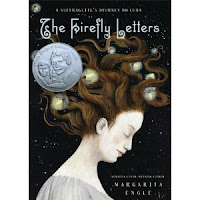
- Bibliography
Engle, Margarita. 2010. THE FIREFLY LETTERS: A SUFFRAGETTE’S JOURNEY TO CUBA. New York: Henry Holt and Co. ISBN 0-689-30072-7
- Summary
This story, written in poetry, is based on the diaries and letters of Fredrika Bremer, a Swedish suffragist who spent three months in Cuba in 1851. The focus is on oppressed women. The book features stories about Fredrika, Cecilia – a teenage slave who was captured in the Congo when she was eight, and Elena – a privileged girl in a slave owning family and how the characters are all connected.
- Critical Analysis
Engle creates dramatic tension among the characters, especially in the story of Elena, who makes a surprising sacrifice. Engle's poetry intertwines three characters that help each other find hope and courage. There are many similes and metaphors for slavery and freedom in the poetry with the main metaphor being cocuyos, a bright firefly that the natives capture in bottles and weave alive into their hair. Rich descriptions of the beauty of Cuba enliven the gentle plotline, from the starlit sky and lush vegetation to the bountiful cocuyos (fireflies), whose flight and capture symbolize freedom and entrapment throughout. Engle has instilled powerful emotions into the free-verse text. The text is rife with metaphors of captivity and freedom: Cecilia’s enslavement is literal, Elena also longs to fly beyond the “ornately barred window” that defines her privileged life, and Fredrika’s relative independence was borne of great sacrifice while inspiring Cecilia and Elena to explore their own purpose.
- Awards and Review Excerpts
- AWARDS -
Pura Belpre Award, 2011 Honor Book Author United States
- REVIEW EXCERPTS -
KIRKUS review: “The free-verse novel effectively alternates the voices of the three protagonists (with a fourth voice for Beni, Cecilia's husband) and demonstrates how each character affects the others, all learning a measure of freedom in their roaming the island, Fredrika always recording her observations in letters and diaries by the light of Cuban fireflies resting on her fingers. And like the firefly light, Engle's poetry is a gossamer thread of subtle beauty weaving together three memorable characters who together find hope and courage.”
THE BULLETIN OF THE CENTER FOR CHILDREN’S BOOKS review: “The author has a gift for imbuing seemingly effortless text with powerful emotions; though this is briefer and less nuanced than her earlier works, it remains memorable nonetheless.”
- Connections
This book can be used as a supplement for lessons on slavery and early feminism.
Students can make personal connections to any struggles they have had in their life and anyone who has helped overcome them.
Develop other similes and metaphors using bugs or animals to describe people, events, personalities, etc. as the fireflies did.

